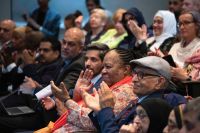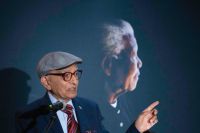
Foundation Board chair Naledi Pandor and Adbul Minty, formerly Honorary Secretary of the British Anti-Apartheid Movement.
On the 29th of October 2024, the Nelson Mandela Foundation launched an exhibition entitled Our Shared Humanity in Action. The exhibition focuses on the role played by the United Nations Special Committee Against Apartheid in dismantling apartheid in South Africa – with the Committee, we believe, being a demonstration of our shared humanity in action.
The exhibition has both a physical and audio-visual dimension. There are exhibition boards where you can view information about the Committee and this is complemented with an audio-visual component. The exhibition will be available for viewing at the Foundation until the end of March 2025. The exhibition is free to view.
More about the UN Special Committee Against Apartheid
The Special Committee Against Apartheid was established by the United Nations General Assembly in 1962, and was originally named the Special Committee on the Policies of Apartheid of the Government of the Republic of South Africa. However, it was renamed in 1975 in order to better reflect its advocacy against apartheid. The Committee held its first meeting in April 1963 and was disbanded in 1994, following South Africa's first democratic elections.
While the Committee was initially tasked with disseminating information on apartheid South Africa, it began to actively promote the international campaign against apartheid. The Committee worked on UN resolutions, advocated for boycotts and sanctions, lobbied member states, organised conferences, collaborated with UN organs and NGOs as well as raised awareness through various mediums including reports and educational materials. It was also comprised of various sub-committees and task force.

Abdul Minty.
Lessons to be drawn from the exhibition
There are many lessons which can be drawn from the exhibition. The exhibition reminds us that what individuals do inside institutions, such as the United Nations, matters and can have a profound impact in achieving justice. Every institution has its limitations which is why solidarity across a variety of institutions and countries matter as each can bring something unique to the overall effort, which can in turn have a multiplier effect. Here we are reminded about the words of Enuga Reddy who held positions as Principal Secretary of the UN Special Committee Against Apartheid and Director of the Centre Against Apartheid:
“During the struggle against apartheid, the Special Committee found it essential to promote the establishment of funds and agencies outside the United Nations (UN), with the assistance of committed Governments and NGOs, to supplement and support UN action, as they were able to do what UN organs could not”
As mentioned, the Committee was established in 1962 yet apartheid was only dismantled in South Africa many decades later. Committee members remained steadfast, no doubt with the understanding that the struggle against injustice is an endeavour which needs persistence and dedication. In the absence of such fortitude, where would we as South Africans be?
Sadly, the exhibition is also a stark reminder that apartheid in South Africa was able to persist for many decades because of the inaction, protection and support of other state and non-state actors. There were many examples of this, illustrated in the reports of the Committee. For instance, in a 1984 Special Committee Against Apartheid Report, the Committee condemned countries who were providing “comfort and encouragement” to the apartheid government:
“The Special Committee, therefore, cannot but express its utmost regret at the policies and actions of the Governments which have found common interests with the Pretoria regime and provided it comfort and encouragement in the pursuit of its crimes against Africa and against humanity. It must make special mention of the Government of the United States of America and the Governments of certain other Western Powers, notably the United Kingdom, as well as the regime of Israel.”
Such words remind us that history can often repeat itself and that the pursuit of realising our shared humanity is an ongoing pursuit.
Relevance to our work
The title of the exhibition draws on a similar theme to the 22nd Nelson Mandela Annual lecture which was Realising our Shared Humanity, which was delivered by Nobel laureate Abdulrazak Gurnah. This exhibition forms part of both the Foundation’s memory work as well as our thought leadership work. The hope is that the exhibition inspires people to draw lessons from the Committee and to see the ways in which similar mechanisms can be mobilised for the benefit of other oppressed peoples.